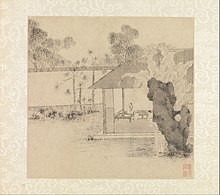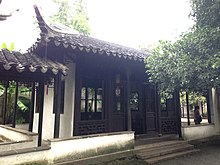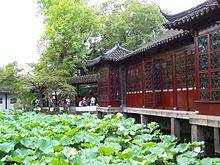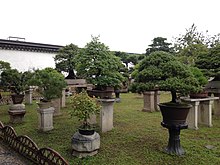Humble Official's Garden
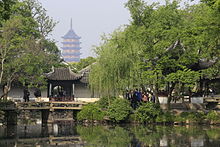
The Garden of the Humble Official , Garden of the Humble Official or Garden of the Unsuccessful Politician ( Chinese 拙政园 / 拙政園 , Pinyin Zhuōzhèng yuán ) is one of the classic gardens in the east Chinese city of Suzhou . It is located in the northeast of the historic district in the Gusu district . It was created in the Ming Dynasty and has been repeatedly changed by different owners since then. Today it contains 32 pavilions and other architectural objects, few of which have anything in common with the original of the Ming Dynasty. Nevertheless, it is considered to be the best-preserved garden from the Ming period. The Garden of the Humble Administrator is one of four gardens in 1997 as a place Classical Gardens of Suzhou in the list of UNESCO world heritage were registered. Already in 1961 it was declared a monument of the People's Republic of China . Together with the Beijing Summer Palace , the Summer Palace of Chengde and the Garden of Lingering, it is one of the four most important gardens in China.
history
The Humble Official's Garden was laid out by Wang Xianchen between 1509 and 1513 , the exact year is unknown and the limitation is based on the records of Wang and the scholar Wen Zhengming. Wang had been an officer in the Imperial Secret Police and was sentenced to two transfers due to conflicts with the military. After his father died in 1510, he decided to lead the life of a landowner in his hometown. He bought the Dahong Temple area, which was burned down when Suzhou was captured by the Ming troops. Wen Zhengming's records state that the site of today's garden in the Tang Dynasty was the estate of the poet Lu Guimeng .
The name "garden of the humble official" appears on documents from 1517 for the first time. Wang chose the name from a rhyme written by the Western Jin Dynasty scholar Pan Yue . Pan had retired from political life to build apartments, plant trees, water a garden, and sell vegetables on an estate. In his prose poem (闲居赋) "in leisure life", he wrote that this was the governance of humble (or unsuccessful) people.
The eminent painter Wen Zhengming painted 31 depictions of the garden under the title Pictures of the Humble Official's Garden, as well as numerous poems and calligraphies, and he also planted a Chinese wisteria himself . Wen Zhengming's records state that the site of today's garden in the Tang Dynasty was the estate of the poet Lu Guimeng . Although it was in the city, it had the air of seclusion in the forest.
Wen's records from 1533 show that the garden was planted with several hundred umes , several hundred apple trees ( Malus asiatica ), several dozen peaches , orange trees and "many" conifers, pagoda trees , cypresses and elms . Ornamental trees such as peonies and scented flowers were planted in only one place in the garden, near the Hall of the Many Scents . This was not atypical for the time: the cities of the Ming dynasty were surrounded by orchards and vegetable gardens, Wang's garden being particularly large. Typically, cash crops were planted in such gardens , which promised very high profits. Citrus fruits were widely traded in what was then China, and their profitability was shrouded in legend. The Asian apples were not eaten raw, but dried and ground, candied or pickled, and they were also used in the dyeing of textiles. Before the introduction of cultivated plants from America, ume was the most important spice used to make staple foods such as rice, millet or steamed bread tasty. Peach vinegar, a luxury product, was made from peaches. Elms were felled after 10 years and the wood was sold to the cities. It is also possible that Wang farmed fish in his garden. This was the most profitable form of agriculture in China in the 16th century, with the water from the ponds being regularly drained to catch the fish. The hydraulics of the ponds in the humble official's garden have this option. In any case, for Wang Xianchen, building the garden was a huge investment and a safe investment. Trading and moneylending, while more profitable, were poorly viewed. Owning land for growing rice or vegetables, however, was highly taxed.
From 1550 rocks from Lake Tai became fashionable. The larger, more riddled and rugged they were, the more valuable they were, and accordingly they were traded for dizzying sums. Since Wen Zhengming's records do not reveal any such rocks, later owners of the garden - probably especially Wang Xinyi - must have procured such rocks. This fashion has been cursed by culturally conservative observers; today artificial limestone cliffs are not only part of the humble official's garden, but also part of the panorama in all of Suzhou's gardens. At around the same time, bonsais came into fashion, and here too the special specimens were sold and bought at very high prices. While at the end of the Ming dynasty less well-off households planted ornamental gardens and replaced fruit trees with bushes imported from Southeast Asia without economic use, the humble official's garden fell into disrepair. Between 1631 and 1633, the eastern part of the garden was separated and a separate garden was created called the Garden for the Return to the Fields, in which mainly peaches, plums and mums were planted.
During the Qing Dynasty , the garden was extensively restored under Emperor Qianlong and was given the name Fu Garden ( 复 园 , Fùyuán ). Towards the end of the Qing Dynasty, the wealthy merchant Zhang Lüqian bought the garden and renamed it the Zhang Family Garden. When the People's Republic of China was established in 1949, the garden was largely destroyed. It was rebuilt roughly on the scale of the Ming Dynasty and opened to the public.
Description of the garden
At 78 mu (5.2 hectares), the humble official's garden is the largest of the Suzhou classical gardens . It consists of three clearly separated areas, the east, middle and west area, whereby the middle area comes closest to the original plant from the Ming dynasty today. However, the garden has more structures today than in the Ming Dynasty.
It is so planted that it is attractive in all seasons. In winter, the plum trees bloom, especially near the pavilion of fragrant snow and colored clouds, while conifers and bamboo remain green and brave the cold. In spring, the flowering crab apples, while in summer the fruits of loquat light golden -Trees. The Chinese rice flowers give off their fragrance in autumn .
Middle area
The traditional entrance area is located on the south side of the central area. It is separated from the street by one of the largest and most elegant screen walls in Suzhou. In the entrance area itself there is an old wisteria that the painter Wen Zhengming planted for his friend Wang Xiachen. The courtyards of the adjoining buildings have elevated walkways so that you don't get your feet wet in Suzhou's climate, which is prone to heavy rainfall. There are trees here that symbolize the four seasons: magnolias for spring, fruit trees such as pears and peaches for summer, trees with beautiful foliage in autumn and conifers for winter. Today the garden museum is located here and visitors now leave the garden through this former entrance area.
On the north side of this complex is the Loquat Courtyard ( 枇杷 园 , Pípa yuán ). It is a small garden with two pavilions: one on the east side and one on a hill on the north side. The pattern of broken ice paving is considered to be one of the best in Suzhou, with the pattern repeated on the windows. To the northwest of the Loquat Court is a moon gate that leads into the garden.
The garden is designed in such a way that the view of the visitor, who enters through the round gate of the Loquat courtyard, wanders over a central pond with a panorama of artificial mountains and rocks. The Hall of Far-Reaching Fragrance ( 远 香 堂 , Yuǎnxiāng Táng ), located immediately to the west of the moon gate, is considered the central building of the garden and a masterpiece of the pavilions glazed on all sides. The windows offer views of the garden like scrolls hanging on the wall. The name of this building is derived from the poem Why I love lotus flowers ( 爱莲说 , Àilián shuō ) by the philosopher Zhou Dunyi , who formulated during the Song Dynasty that the lotus growing out of the pond mud is proof that dirt can also be found Beauty and honesty can arise. In the summer, numerous lotus flowers and irises grow in front of the wide terrace that adjoins the Hall of the Extensive Fragrance .
To the east of this is the Xiuqi Pavilion ( 绣 绮 亭 , Xiùqǐ Tíng ) perched on a hill, further east is an arrangement of buildings, to which the Hall of Perfected Elegance ( 玲珑 馆 , Línglóng Guǎn ) and the Pavilion for Hearing the Rain ( 听雨轩 , Tīngyǔ Xuān ) count. From the east side of the pond, at the place of retreat under Firmiana and bamboo ( 梧 竹 幽居 , Wúzhú Yōujū ), there is a view over the pond and the garden to the north temple pagoda outside the garden. On the islands of the pond there is a walkable rock and mountain landscape, which offers many different perspectives on the garden and its buildings. Maples , pines , willows and tangerines grow on the islands, which rise from a landscape of lotus flowers in summer . On the western of the two islands is the pavilion of fragrant snow and colored clouds ( 雪香 云 蔚 亭 , Xuěxiāng Yúnwèi Tíng ). Below this, connected to the mainland by two bridges, is the pavilion with lotus and wind from all four sides ( 荷风 四面 亭 , Héfēng Sìmiàn Tíng ). The bridges not only serve as walkways, they also loosen up the scenery. To the northwest of the two islands is the tower built into the water to see the mountain ( 见 山 阁 , Jiànshān Gé ).
On the south side of the pond there is also the Azure Wave Pavilion ( 小 沧浪 , Xiǎo Cānglàng ), which is named after the Azure Wave Garden - this already existed when the construction of the humble official's garden began. In the immediate vicinity is the Little Flying Rainbow Bridge ( 小 飞虹 , Xiǎo fēihóng ), one of the few wooden bridges in the gardens of Suzhou, which elegantly spans the water surface of the pond and the scenery of the rather calm, but dense livened up corner of the garden in which it is located. The Magnolia Hall ( 玉兰 堂 , Yùlán Táng ) and the Pavilion for Achieving Truthfulness ( 得 真 亭 , Dézhēn Tíng ) are also located here. On the north side of this complex a marble ship is anchored at the Fragrant Island ( 香洲 , Xiāng Zhōu ).
To the northwest of the pond is a complex of small buildings, corridors, walls and pillars through which the visitor can walk and which reveal new and different perspectives at every turn. Also near this complex is the gate that leads to the western area of the garden.
Western area
In the western part of the garden there is also a pond that is stretched in a north-south direction. On its north side stands the two-story tower of the water reflection ( 倒 影楼 , Dǎoyǐng Lóu ), whose exquisitely made windows reveal views of the water surface. On the opposite bank, the hall of the 36 mandarin ducks ( 卅六 鸳鸯 馆 , Sàliù yuānyāng guǎn ) on the western bank of the pond is supported by pairs of round and angular columns. The name of this building alludes to the lifelong relationship the mandarin ducks form . On the western bank, connected to the hall of the 36 mandarin ducks by a bridge, is the house for lingering and listening ( 留 听 阁 , Liútīng Gé ), whose architecture resembles the hull of a ship. The garden section south of these buildings is densely planted, the pond narrows here in such a way that the impression arises that the inlet of the pond is from a rock spring.
To the south of the gate between the central and western areas are two pavilions on a rock ( 宜 两 亭 , Yíliáng Tíng ), from where you can look into the central area of the garden. Below these rocks there is a winding stream and a stone in the shape of a pagoda. The pavilion immediately next to it has a fan-shaped floor plan and fan-shaped windows. Next to it is a particularly elegant complex of corridors and rooms that wind to form a stylized boat berth.
The west area of the garden houses a collection of around 700 Suzhou-style bonsai pots on a large, level area separated from the rest of the garden by a wall .
Eastern area
The eastern area, which was separated from the garden complex for a long time, has - unusual for a Chinese garden - larger flat lawns and stylized vegetable patches made of flowers: The eastern area was known as the Garden for the Return to the Fields ( 归 田园 居 , Guītián Yuánjū , from the later Ming dynasty onwards ) an independent garden. There is a relatively high mound of earth and huge trees in the middle of a pond. Despite its size, this area contains only two large and two small pavilions. The entrance for visitors is now at the southeast end of this area.
literature
- 苏州 园林 发展 股份有限公司, 苏州 市 世界 文化遗产 古典 园林 保护 监管 中心, 苏州 市 拙政园 管理 处 (Ed.): 凝固 的 乐章 —— 苏州 拙政园 建筑 (Music made into shape - architecture of the garden of the humble official ) . 中国 建筑 工业 出版社, 2018, ISBN 978-7-112-21217-0 (Chinese).
- 韦秀玉 (Ed.): 古雅 空间 —— 文徵明 《拙政园 三十 一 景 图》 研究 (Examination of 31 depictions of the garden of the humble official of Wen Zhengming) . 人民出版社, 2014, ISBN 978-7-01-016793-0 (Chinese).
Web links
Individual evidence
- ↑ Craig Clunas: Fruitful sites: Garden culture in Ming dynasty China . Duke University Press, Durham 1996, ISBN 0-8223-1800-8 , pp. 30 .
- ↑ Classical Gardens of Suzhou / Jardins classiques de Suzhou on the UNESCO World Heritage Center website ( English and French ).
- ↑ a b 国家 文物 局 (Ed.): 全国 重点 文物保护 单位 (第 一批 至 第五批) . 1st edition. tape 1 . 文物 出版社, Beijing 2004, ISBN 978-7-5010-1525-2 , pp. 637 f . (Chinese).
- ↑ a b c d e f g h i 袁学汉, 龚建毅: 苏州 园林 名胜 . 2nd Edition. 内蒙古 人民出版社, 2005, ISBN 7-204-05094-0 , p. 25-27 .
- ↑ Craig Clunas: Fruitful sites: Garden culture in Ming dynasty China . Duke University Press, Durham 1996, ISBN 0-8223-1800-8 , pp. 22-24 .
- ↑ Craig Clunas: Fruitful sites: Garden culture in Ming dynasty China . Duke University Press, Durham 1996, ISBN 0-8223-1800-8 , pp. 52 .
- ↑ Craig Clunas: Fruitful sites: Garden culture in Ming dynasty China . Duke University Press, Durham 1996, ISBN 0-8223-1800-8 , pp. 39-49 .
- ↑ Craig Clunas: Fruitful sites: Garden culture in Ming dynasty China . Duke University Press, Durham 1996, ISBN 0-8223-1800-8 , pp. 66-77 .
- ↑ a b c Lou Qingxi: Chinese gardens: in search of landscape paradise . 3. Edition. China Intercontinental Press, Beijing 2016, ISBN 978-7-5085-3379-7 , pp. 34-38 .
- ↑ a b c d e f g Ron Henderson: The gardens of Suzhou . University of Pennsylvania Press, Philadelphia 2013, ISBN 978-0-8122-2214-2 , pp. 33-42 .
Coordinates: 31 ° 19 ′ 34.6 ″ N , 120 ° 37 ′ 28.3 ″ E
